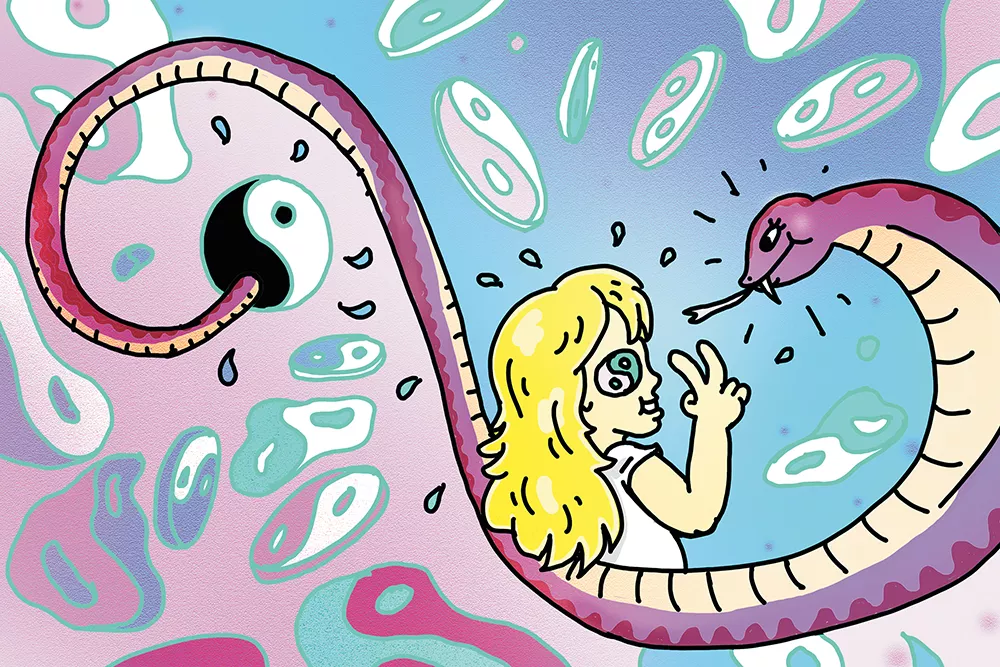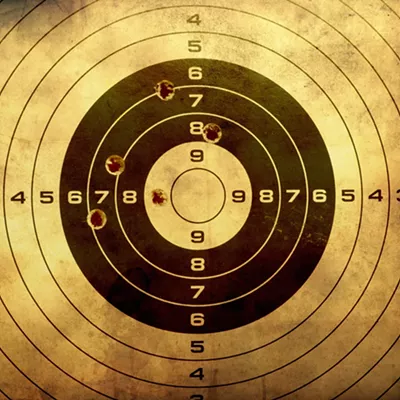The now iconic yin yang symbol originated in 1991, when it presented itself to me in holographic-sticker form in a pizza parlor sticker machine. The yin yang was an odd, eye-catching form made of starkly contrasted shapes that were familiar and also foreign: a circle with an S shape inside, separating a black side from a holographic silver side, then additional, smaller circles within those shapes, in opposite colors as the side they were on, creating more contrast. There were lots of symbols in the world that I didn't understand. I was 5, after all.
I gathered some facts:
- A single sticker was ejected from the sticker machine between two pieces of cardboard.
- It cost two quarters.
- There was another yin yang design in the sticker machine, this one with a cobra slithering out of the two smaller circles.
- The cobra could be a sexual metaphor, since penises were snakes. (My cousin David told me that.)
The yin yang, I deduced, was a symbol of sex, something dark and mysterious I should stay away from.
The yin yang then wallowed in obscurity until 1995, when my Uncle Drew gave me a set of Pogs for my ninth birthday. Not every uncle is creepy, but the fact that you usually want to specify whether or not an uncle is is a pretty solid indicator of how many creepy ones there are. This one was creepy.
Many of the Pogs were "sexy skeleton" themed: skeletons in bikinis, skeletons posing like pinup girls, skeletons caught in the act of dropping a hanky and, randomly, skeletons playing golf. The set also included a silver slammer engraved with a yin yang. The sexual imagery was much more obvious to me now, as I was more mature and worldly. The interior shapes depicted two bodies interlacing; the circles on either side representing those bodies' holes. There was probably more to it, too, that I didn't understand because I was too young.
"Disgusting," I thought, and quickly (though unintentionally) lost all my Pogs in a swift recess time defeat "for keeps."
By 1997, I had begun my collection of smiley face T-shirts. What had started as a mild interest in the expressive yellow form quickly turned into an all-out obsession once I figured out that exaggerating a new interest could diminish my previous reputation of being obsessed with cats, which now, at 12 years old, seemed babyish and embarrassing. At Claire's, looking for smiley face accessories to wear with my smiley face shirts, I found a pair of earrings emblazoned with the yin yang. The symbol was making another emergence into current teenage trends. I reacted to it as though I had found someone's secret porn stash, stuffing the earrings back into the jewelry rack and, red-faced, fleeing from the store before anyone saw what I was looking at. I thought about the earrings later, like a dirty secret, wishing I had looked at them for a few moments longer.
Soon, the yin yang was on every choker necklace, skateboard and blacklight poster I came across. Or maybe I just noticed the symbol more because I was entering my teen years and was becoming more interested in sex and therefore more likely to see it.
At the bottom of a "prize candle" I lit for ambiance while listening to CDs and staring at my bedroom ceiling, I found a small metal yin yang charm. Alone in my room, I considered this symbol with more open-mindedness than I ever had before, rolling it around in my palm, rubbing wax out of its crevices. Maybe the yin yang wasn't something I needed to fear anymore. I could reinterpret its meaning to be something useful in my life instead of symbolic of all the things I didn't understand. Maybe, I thought, symbols don't have to have the same meaning for you that they do for other people. ♦
Chelsea Martin is the Spokane-based author of five books, including Caca Dolce: Essays from a Lowbrow Life. Her website is jerkethics.com.

















